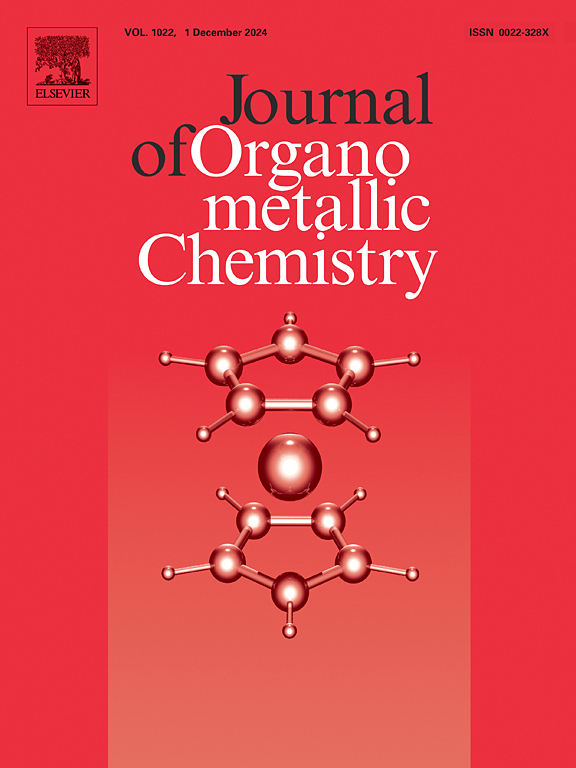Synthesis of 2,3-dihydrobenzo[b][1,4]oxatellurane derivatives from propargyl ethers
IF 2.1
3区 化学
Q3 CHEMISTRY, INORGANIC & NUCLEAR
引用次数: 0
Abstract
The reaction of substituted phenyl propargyl ethers with tellurium tetrachloride resulted in the formation of (E)-3‐(chloromethylene)-2,3-dihydrobenzo[b][1,4]oxatelluranes, which were isolated as crystalline 4,4-dibromo derivatives. The products represent the first reported bicyclic [1,4]benzoxatelluranes. Their formation indicates preferential anti addition of tellurium tetrachloride across the C![]() C triple bonds of the chosen propargyl ethers with anti-Markovnikov regioselectivity, contrasting earlier reports of preferential syn addition of tellurium tetrachloride to alkynes. This likely results from the intermediacy of tellurenium cations stabilized by intramolecular Te-O coordination. The resulting adducts underwent electrophilic cyclization under the conditions of their formation. X-ray analyses obtained for two product molecules showed substantial deviations from planarity for the heterocyclic part of these molecules. No Te-O secondary bonding interactions were observed, but Te-Br secondary bonding was present. (E)-3‐(Chloromethylene)‐6,7-dimethyl-2,3-dihydrobenzo[b][1,4]oxatellurane, prepared by reduction of its 4,4-dibromo derivative, presented as a thick oxidation prone oil. 125Te NMR chemical shifts are compared to those of structurally similar compounds.
C triple bonds of the chosen propargyl ethers with anti-Markovnikov regioselectivity, contrasting earlier reports of preferential syn addition of tellurium tetrachloride to alkynes. This likely results from the intermediacy of tellurenium cations stabilized by intramolecular Te-O coordination. The resulting adducts underwent electrophilic cyclization under the conditions of their formation. X-ray analyses obtained for two product molecules showed substantial deviations from planarity for the heterocyclic part of these molecules. No Te-O secondary bonding interactions were observed, but Te-Br secondary bonding was present. (E)-3‐(Chloromethylene)‐6,7-dimethyl-2,3-dihydrobenzo[b][1,4]oxatellurane, prepared by reduction of its 4,4-dibromo derivative, presented as a thick oxidation prone oil. 125Te NMR chemical shifts are compared to those of structurally similar compounds.

丙炔醚合成2,3-二氢苯并[b][1,4]草戊烷衍生物
取代苯丙基醚与四氯化碲反应生成(E)-3‐(氯甲基)-2,3-二氢苯并[b][1,4]草胺醚,分离得到结晶型4,4-二溴衍生物。该产物是首次报道的双环[1,4]苯并草特拉烷。它们的形成表明四氯化碲在丙炔醚的CC三键上具有反马尔可夫尼科夫区选择性的优先反加成反应,与早先报道的四氯化碲在炔上的优先同步加成反应形成对比。这可能是由于分子内Te-O配位稳定的碲阳离子的中介作用。生成的加合物在形成条件下发生亲电环化。对两个产物分子的x射线分析表明,这些分子的杂环部分与平面度有很大的偏差。没有观察到Te-O二级键相互作用,但存在Te-Br二级键。(E)-3‐(氯甲基)‐6,7-二甲基-2,3-二氢苯并[b][1,4]草叶乙烷是由其4,4-二溴衍生物还原而成的稠性易氧化油。125nmr化学位移与结构相似的化合物进行比较。
本文章由计算机程序翻译,如有差异,请以英文原文为准。
求助全文
约1分钟内获得全文
求助全文
来源期刊

Journal of Organometallic Chemistry
化学-无机化学与核化学
CiteScore
4.40
自引率
8.70%
发文量
221
审稿时长
36 days
期刊介绍:
The Journal of Organometallic Chemistry targets original papers dealing with theoretical aspects, structural chemistry, synthesis, physical and chemical properties (including reaction mechanisms), and practical applications of organometallic compounds.
Organometallic compounds are defined as compounds that contain metal - carbon bonds. The term metal includes all alkali and alkaline earth metals, all transition metals and the lanthanides and actinides in the Periodic Table. Metalloids including the elements in Group 13 and the heavier members of the Groups 14 - 16 are also included. The term chemistry includes syntheses, characterizations and reaction chemistry of all such compounds. Research reports based on use of organometallic complexes in bioorganometallic chemistry, medicine, material sciences, homogeneous catalysis and energy conversion are also welcome.
The scope of the journal has been enlarged to encompass important research on organometallic complexes in bioorganometallic chemistry and material sciences, and of heavier main group elements in organometallic chemistry. The journal also publishes review articles, short communications and notes.
 求助内容:
求助内容: 应助结果提醒方式:
应助结果提醒方式:


